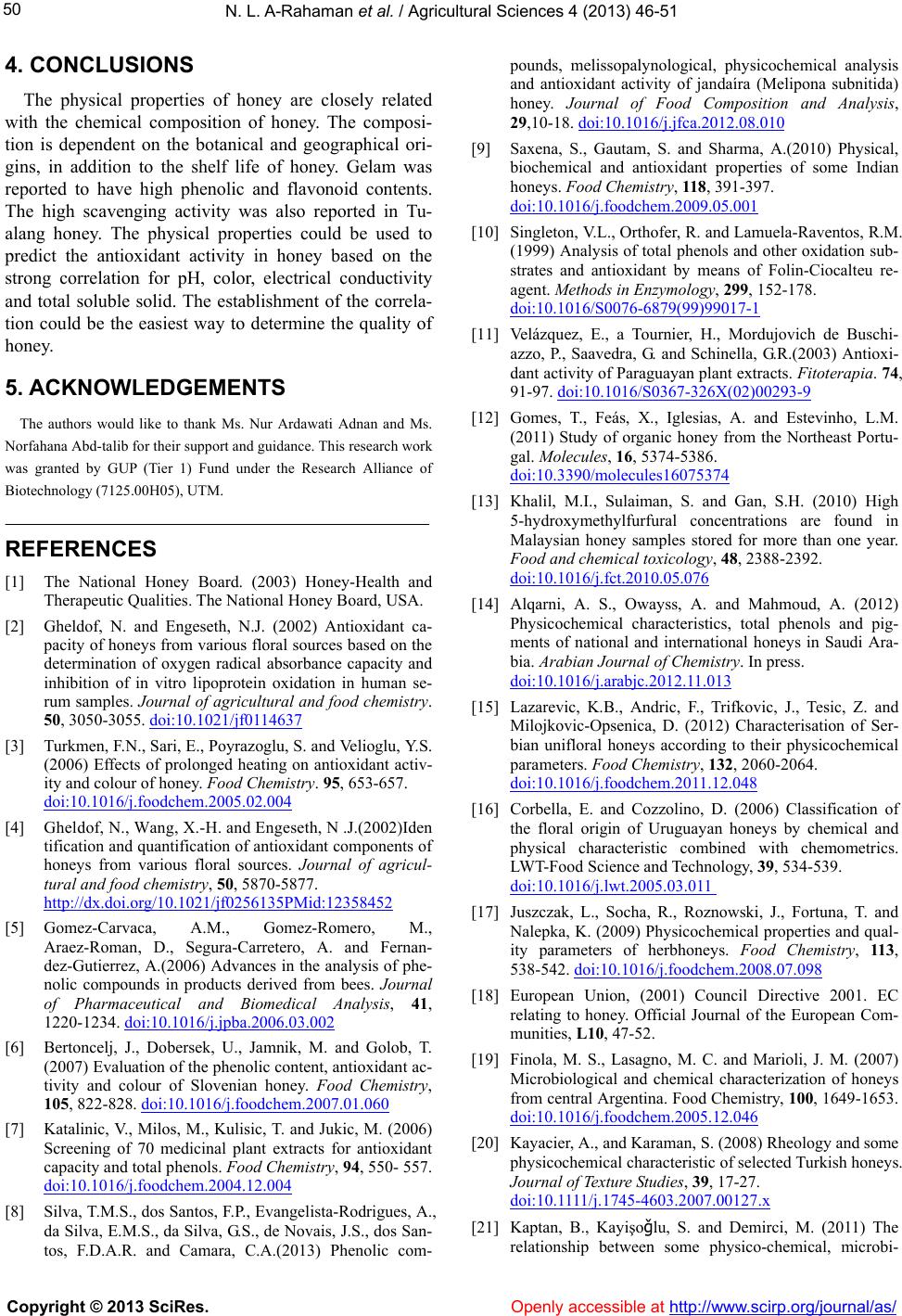
N. L. A-Raham an et al. / Agricultura l Sciences 4 (2013) 46-51
50
4. CONCLUSIONS
The physical properties of honey are closely related
with the chemical composition of honey. The composi-
tion is dependent on the botanical and geographical ori-
gins, in addition to the shelf life of honey. Gelam was
reported to have high phenolic and flavonoid contents.
The high scavenging activity was also reported in Tu-
alang honey. The physical properties could be used to
predict the antioxidant activity in honey based on the
strong correlation for pH, color, electrical conductivity
and total soluble solid. The establishment of the correla-
tion could be the easiest way to determine the quality of
honey.
5. ACKNOWLEDGEMENTS
The authors would like to thank Ms. Nur Ardawati Adnan and Ms.
Norfahana Abd-talib for their support and guidance. This research work
was granted by GUP (Tier 1) Fund under the Research Alliance of
Biotechnology (7125.00H05), UTM.
REFERENCES
[1] The National Honey Board. (2003) Honey-Health and
Therapeutic Qualities. The National Honey Board, USA.
[2] Gheldof, N. and Engeseth, N.J. (2002) Antioxidant ca-
pacity of honeys from various floral sources based on the
determination of oxygen radical absorbance capacity and
inhibition of in vitro lipoprotein oxidation in human se-
rum samples. Journal of agricultural and food chemistry.
50, 3050-3055. doi:10.1021/jf0114637
[3] Turkmen, F.N., Sari, E., Poyrazoglu, S. and Velioglu, Y.S.
(2006) Effects of prolonged heating on antioxidant activ-
ity and colour of honey. Food Chemistry. 95, 653-657.
doi:10.1016/j.foodchem.2005.02.004
[4] Gheldof, N., Wang, X.-H. and Engeseth, N .J.(2002)Iden
tification and quantification of antioxidant components of
honeys from various floral sources. Journal of agricul-
tural and food chemistry, 50, 5870-5877.
http://dx.doi.org/10.1021/jf0256135PMid:12358452
[5] Gomez-Carvaca, A.M., Gomez-Romero, M.,
Araez-Roman, D., Segura-Carretero, A. and Fernan-
dez-Gutierrez, A.(2006) Advances in the analysis of phe-
nolic compounds in products derived from bees. Journal
of Pharmaceutical and Biomedical Analysis, 41,
1220-1234. doi:10.1016/j.jpba.2006.03.002
[6] Bertoncelj, J., Dobersek, U., Jamnik, M. and Golob, T.
(2007) Evaluation of the phenolic content, antioxidant ac-
tivity and colour of Slovenian honey. Food Chemistry,
105, 822-828. doi:10.1016/j.foodchem.2007.01.060
[7] Katalinic, V., Milos, M., Kulisic, T. and Jukic, M. (2006)
Screening of 70 medicinal plant extracts for antioxidant
capacity and total phenols. Food Chemistry, 94, 550- 557.
doi:10.1016/j.foodchem.2004.12.004
[8] Silva, T.M.S., dos Santos, F.P., Evangelista-Rodrigues, A.,
da Silva, E.M.S., da Silva, G.S., de Novais, J.S., dos San-
tos, F.D.A.R. and Camara, C.A.(2013) Phenolic com-
pounds, melissopalynological, physicochemical analysis
and antioxidant activity of jandaíra (Melipona subnitida)
honey. Journal of Food Composition and Analysis,
29,10-18. doi:10.1016/j.jfca.2012.08.010
[9] Saxena, S., Gautam, S. and Sharma, A.(2010) Physical,
biochemical and antioxidant properties of some Indian
honeys. Food Chemistry, 118, 391-397.
doi:10.1016/j.foodchem.2009.05.001
[10] Singleton, V.L., Orthofer, R. and Lamuela-Raventos, R.M.
(1999) Analysis of total phenols and other oxidation sub-
strates and antioxidant by means of Folin-Ciocalteu re-
agent. Methods in Enzymology, 299, 152-178.
doi:10.1016/S0076-6879(99)99017-1
[11] Velázquez, E., a Tournier, H., Mordujovich de Buschi-
azzo, P., Saavedra, G. and Schinella, G.R.(2003) Antioxi-
dant activity of Paraguayan plant extracts. Fitoterapia. 74,
91-97. doi:10.1016/S0367-326X(02)00293-9
[12] Gomes, T., Feás, X., Iglesias, A. and Estevinho, L.M.
(2011) Study of organic honey from the Northeast Portu-
gal. Molecules, 16, 5374-5386.
doi:10.3390/molecules16075374
[13] Khalil, M.I., Sulaiman, S. and Gan, S.H. (2010) High
5-hydroxymethylfurfural concentrations are found in
Malaysian honey samples stored for more than one year.
Food and chemical toxicology, 48, 2388-2392.
doi:10.1016/j.fct.2010.05.076
[14] Alqarni, A. S., Owayss, A. and Mahmoud, A. (2012)
Physicochemical characteristics, total phenols and pig-
ments of national and international honeys in Saudi Ara-
bia. Arabian Journal of Chemistry. In press.
doi:10.1016/j.arabjc.2012.11.013
[15] Lazarevic, K.B., Andric, F., Trifkovic, J., Tesic, Z. and
Milojkovic-Opsenica, D. (2012) Characterisation of Ser-
bian unifloral honeys according to their physicochemical
parameters. Food Chemistry, 132, 2060-2064.
doi:10.1016/j.foodchem.2011.12.048
[16] Corbella, E. and Cozzolino, D. (2006) Classification of
the floral origin of Uruguayan honeys by chemical and
physical characteristic combined with chemometrics.
LWT-Food Science and Technology, 39, 534-539.
doi:10.1016/j.lwt.2005.03.011
[17] Juszczak, L., Socha, R., Roznowski, J., Fortuna, T. and
Nalepka, K. (2009) Physicochemical properties and qual-
ity parameters of herbhoneys. Food Chemistry, 113,
538-542. doi:10.1016/j.foodchem.2008.07.098
[18] European Union, (2001) Council Directive 2001. EC
relating to honey. Official Journal of the European Com-
munities, L10, 47-52.
[19] Finola, M. S., Lasagno, M. C. and Marioli, J. M. (2007)
Microbiological and chemical characterization of honeys
from central Argentina. Food Chemistry, 100, 1649-1653.
doi:10.1016/j.foodchem.2005.12.046
[20] Kayacier, A., and Karaman, S. (2008) Rheology and some
physicochemical characteristic of selected Turkish honeys.
Journal of Texture Studies, 39, 17-27.
doi:10.1111/j.1745-4603.2007.00127.x
[21] Kaptan, B., Kayişoǧlu, S. and Demirci, M. (2011) The
relationship between some physico-chemical, microbi-
Copyright © 2013 SciRes. Openly accessible at http://www.scirp.org/journal/as/